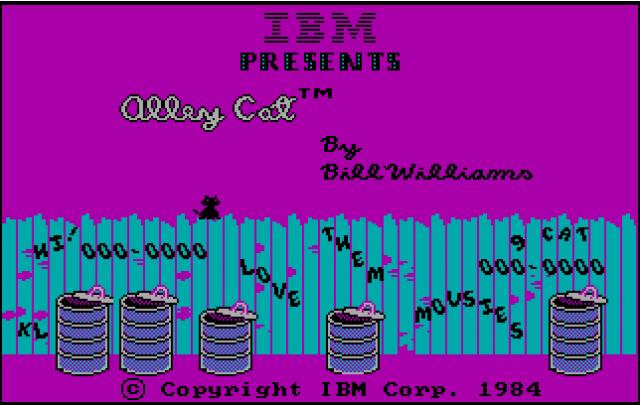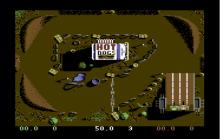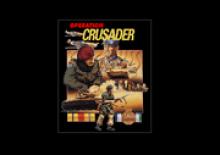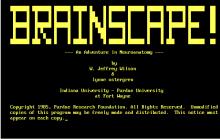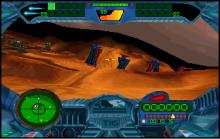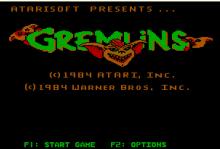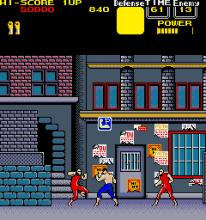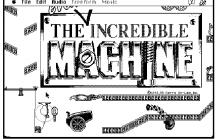Alley Cat
Press Keyboard right side: Alt+Enter keys to switch to full screen game play, and Alt+Enter keys to return.
How to play Alley Cat
Each game uses different controls, most DOS games use the keyboard arrows. Some will use the mouse.
Alley Cat Description
Alley Cat is a computer game created by Bill Williams and published by Synapse Software for the Atari 8-bit family in 1983, and later for the PC in 1984 by IBM. The player controls Freddy the Cat, an alley cat whose object is to perform certain tasks within the homes of people in order to reach to his love Felicia.[1] A similar game also called Alley Cat, from 1984 and distributed by Solar Software, was released for the Commodore 64 PC.
In the main screen, which is the alley, the player is presented with a tall fence in front of an apartment building with several windows. Each window periodically opens to throw out random objects (a phone, shoe, etc.) Every once in a while a dog may come running along the bottom edge of the screen. If the cat touches this dog, they get into a fight and one life is taken away.
By jumping and climbing trash cans, the fence, and clotheslines, the cat can enter various rooms through the open windows. Each room contains one of several challenges:
In one room there's a table with a birdcage on it in the middle of the room. Here the objective is to push the birdcage off the table and then catch the bird which escapes from the broken cage.
In another room, there's a fishbowl which the cat can enter and must eat all the fish while dodging electric eels and repeatedly coming up for air to avoid drowning.
Yet another room contains a huge chunk of cheese with a number of holes. In each hole mice appear randomly, which the cat must catch.
The cat may also find itself in a room with a number of sleeping dogs, some of which have feeding dishes in front of them. The cat must empty each dish without waking up any of the dogs.
Most rooms also contain a broomstick that constantly moves around the screen. The cat can keep the broom busy by making footprints on the ground (at the bottom edge of the screen.) When there are no footprints, the broom will constantly go after the cat.
The broom is harmless in the sense that it never kills the cat, but it pushes the cat around, enough to make it more difficult if it is not kept busy. In particular, the broom might often throw the cat right at the above-mentioned dog or spider, or throw it right back out of the window.
Successful completion of the challenge is awarded with a number of points proportional the time taken to complete it. The player then returns to the alley where open windows now show a female cat calling him.
Upon entering such a window, the player encounters a room in which there are several rows (a bit like shelves) made out of valentine hearts on which other cats walk left and right and constantly try to cock-block the player. The object is to reach the cat at the top while maneuvering around the other cats, which cause the player to fall a level if touched.
Each "row" has areas the player can stand on as well as areas where they fall through (the other cats however never fall through.) These areas are hearts which switch between normal and broken as they are touched by heart-shaped arrows that are constantly shot diagonally across the screen by cherubs on either side of the screen. These arrows also cause the player to fall down a level.
There are also gifts on the bottom row that can be used to eliminate an unfriendly cat for a short period of time. If the player falls from the bottom row, they fail and must return to the alley and complete another task.
If the cat manages to kiss the female cat in the special room, the level advances by one and the player gains an extra life. The games difficulty level continues to increase until multiplier level 30 at which point it stays the same. Gameplay at this level can continue indefinitely. The goal is to see how far one can go before running out of lives.
The PC version was designed to be run from a boot disk. A modified version was created which was intended to run on MS-DOS or PC-DOS, but still works on its successors, including Microsoft Windows (although not the x86_64 variants, which lack MS-DOS support; however, using a DOS emulator addresses this issue). It runs at 320x200 resolution, features four-colour CGA graphics (the most common colors to be onscreen at once are black, white, cyan and magenta or black, red, yellow and green) and PC speaker sound and music. The game is very compact, stored entirely within a single COM file of 56,448 bytes.
The Atari 800 version came in the form of either a floppy disk or cassette, and is even smaller in size, only 32,594 bytes.
